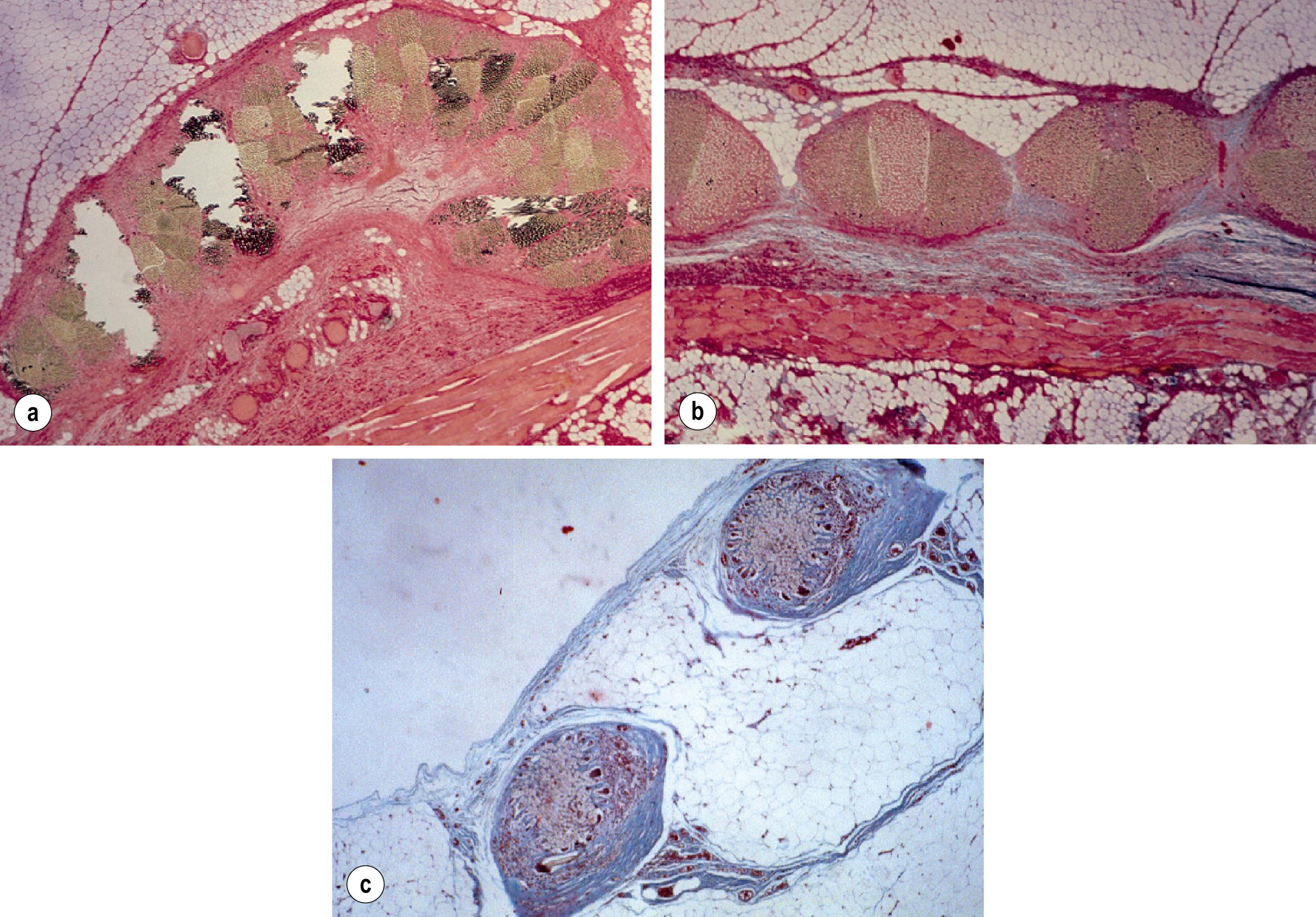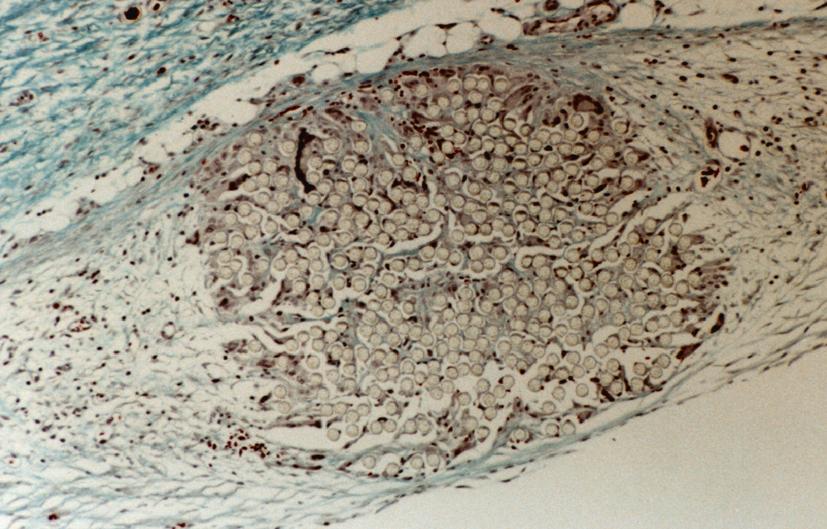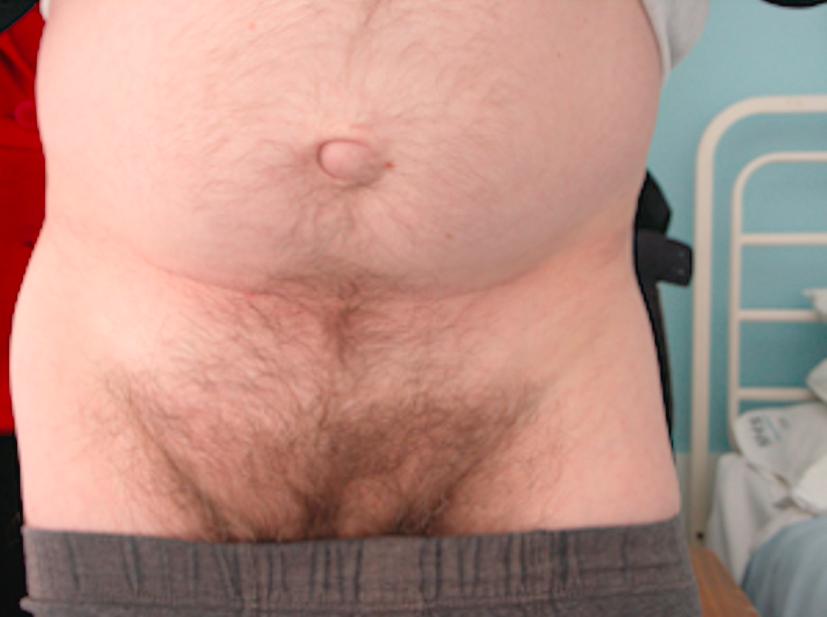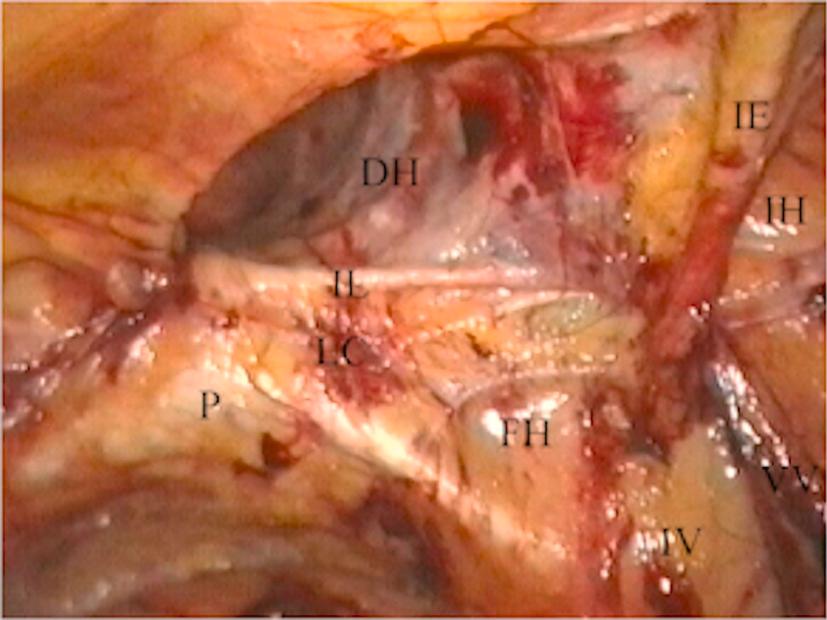Physical Address
304 North Cardinal St.
Dorchester Center, MA 02124
A hernia is defined as an abnormal protrusion of a cavity’s contents through a weakness in the wall of the cavity, taking with it all the linings of the cavity, although these may be markedly attenuated. With any definition, there will be exceptions to the rule—is a lipoma of the cord a hernia? A hernia can be described as reducible, incarcerated or strangulated. A reducible hernia is one in which the contents of the hernial sac can be manually introduced back into the abdomen; conversely, an irreducible or incarcerated hernia cannot be manipulated back into the abdomen. A strangulated hernia occurs when the vascular supply to the contents contained within the hernia is compromised, resulting in tissue ischaemia.
Multiple factors contribute to the development of hernias. Hernias are associated with a number of medical conditions, including connective tissue disorders such as Ehlers–Danlos syndrome, as well as a number of abnormal collagen-related disorders such as varicose veins and arterial aneurysm. In essence, hernias can be considered design faults, either anatomical or through inherited collagen disorders, although these two aetiological factors probably work together in the majority of patients. Anatomical design faults can be considered at any site where structures within the cavity exit through an opening in the wall of the cavity, such as blood vessels, bowel or the spermatic cord. This is typical, for example around the oesophagus and in the groin. However, not everyone develops a groin hernia, so other factors must be important in its aetiology. The fascia and surrounding tissues that cover muscle, acting to hold the muscle bundles together, may appear relatively avascular, but it remains a complex and living structure. The genetic code for fascia is coded on DNA, and within fibroblasts the sequence is messenger RNA, transfer RNA, peptide formation, with fusion of peptides into approximately 1000 amino acid polypeptides called alpha chains. The endoplasmic reticulum converts these to procollagen. Procollagen is the large building block of collagen, comprising triple-helix strands, stabilised by hydroxylation of proline and lysine, which is vitamin C dependent. These triple-helix strands form microfibrils, then fibrils, then fibres and finally bundles. These collagen bundles surrounded by extracellular matrix comprise fascia. The control of this process is mediated through matrix metalloproteinases, which in turn are controlled by tissue inhibitory metalloproteinases. If this is not complex enough, there is also control by collagen-interacting proteins and receptors such as fibronectin, tenasin and collagen receptor discoidin domain receptor 2. Fascia and tendon are made up of type I and type III collagen (type II is found in cartilage and type IV in the basement membrane of cells). In cross-section, there is a bimodal distribution of bundle size with the fibres orientated in the line of pull. The larger bundles are type I collagen, imparting the strength to the fascia or tendon. The type III collagen bundles are smaller and are thought to provide elastic recoil following stretch when the tissues have been loaded. The type I to III collagen ratio varies between individuals but is constant in all the fascia of a particular individual.
A clinical observation was made by surgeons in the late 1960s that the anterior rectus sheath some distance from the hernial defect was thinner than normal, especially in those patients with direct hernias. Since then, research has demonstrated a variety of defects in collagen synthesis in such patients. The current notion is that the majority of hernias are a disease of collagen metabolism. One of the key factors in this is the type I to III collagen ratio. The lower this ratio, from an average of around 5, the more likely the individual is to develop a hernia. Currently, collagen typing is not used in clinical practice to help decide perhaps which patients merit a mesh as opposed to a suture repair, but this may well be a development in the near future.
![]() Hernias are a collagen disease, with reduced collagen type I to III ratio.
Hernias are a collagen disease, with reduced collagen type I to III ratio.
A number of hernia classifications exist, both for the description of hernia characteristics such as size and location and also hernia surgery-related complications. The use of such classifications aids the reporting of hernia series, reducing the risk of comparing ‘apples with oranges’. For example, the use of mesh in the repair of small hernias in general does not have such a marked benefit in terms of reducing hernia recurrence compared to larger hernia defects. Classifications based on size and location allow the surgeon to think more about tailored surgery, as one operation technique does not always fit all. The European Hernia Society inguinal hernia classification and the EuraHS ventral hernia classification are two such useful pragmatic classifications.
Much will be mentioned about mesh repairs of hernias in the remainder of this chapter, but this section gives a brief overview of mesh and its science. Many companies produce a variety of mesh for hernia repair. These are either synthetic (man-made) or biological (preparations from animal or human tissue). The majority of synthetic meshes are woven from either polypropylene (monofilament) or polyester (multi- and monofilament), but new polymers continue to be developed. Biological meshes are typically animal collagen, either from skin or bowel, but there are also human preparations. Biological meshes tend to be much more expensive and should be reserved for specialist use.
It goes without saying that any mesh should have the usual properties of any implant, including being non-allergenic, non-carcinogenic, have good incorporation into tissue and mimic the tissue it is replacing or reinforcing. The abdominal wall is not a rigid structure, but regularly copes with increases in abdominal pressure on coughing and sneezing, etc. of up to 200 mmHg. The abdominal wall elasticity is greater in women than in men and is greater in the cranio-caudal direction than transversely or obliquely. The traditional standard weight polypropylene mesh, of around 100 g/m 2 , is significantly over-engineered, with a burst strength at least an order of magnitude greater than the anterior abdominal wall and an elasticity of much less. As a result, there are now many polypropylene meshes on the market of lighter weight. However, ‘lightweight’ is a misnomer. Some heavyweight meshes behave in a ‘lightweight’ fashion and vice versa, as it is not just the weight of the mesh that imparts mesh elasticity and flexibility. The weave of the strands in the mesh may impart varying flexibility or elasticity to the mesh in different directions of pull, so-called anisotropy. Pore size or the size of the large holes in the mesh is also important. Mesh has a volume with length, breadth and thickness. The amount of empty space within the ‘volume’ of the mesh is the porosity and the effective porosity is the amount of empty space within the volume of the mesh made up of holes that are bigger than 1 mm diameter. It has been proposed that an effective porosity of a mesh for hernia repair should be at least 60%. Fibrosis will occur around each strand of the mesh. If the strands are close together, the fibrosis around each strand will coalesce, forming a solid scar plate. As the scar plate matures, it will shrink, reducing the overall size of the mesh. The minimum pore size should be about 1 mm 2 , but many meshes have pore sizes around 3–5 mm. Increasing the macroporosity of the mesh produces a scar net, rather than a scar plate, with normal tissue in between the fibre/scar complex, reducing mesh/scar shrinkage and improving flexibility ( Fig. 7.1 ). Furthermore, increasing the macropore size reduces the bulk of the foreign body implant, and their use in contaminated fields, due to reduced bacterial adherence and increased bacterial clearance, is becoming acceptable practice. In addition to the macropore size, mesh also has micropores within the mesh material itself. These should be at least 10 μm in size. If the micropore size is smaller, bacteria can harbour in the pores out of reach of the larger inflammatory cells.

The majority of synthetic meshes in the UK are polypropylene. Gore-Tex and other polytetrafluoroethylene (PTFE)-based meshes also have some popularity. PTFE has no macropores so will be encapsulated by fibrous tissue with minimal tissue ingrowth. Polyester-based meshes are gaining popularity and have some advantages over polyproplyene but are mostly multifilament rather than monofilament. The multifilament arrangement increases the developed surface of the mesh (around 10-fold) and thus improves tissue incorporation. As a result, the peel strength (the effort required to separate the mesh from the tissues once it is incorporated) is greater ( Fig. 7.2 ).

The latest mesh category is slowly resorbable synthetic mesh, with resorption taking many months to years. It is hoped that such meshes will reduce the sensation of mesh, or the risk of problems from mesh infection, but there are no long-term data available to comment on hernia recurrence risk, for example.
![]() Preferred mesh should be ‘lightweight’ (<80 g/m 2 ), large pore (>1 mm) and macroporous (>10 μm).
Preferred mesh should be ‘lightweight’ (<80 g/m 2 ), large pore (>1 mm) and macroporous (>10 μm).
Traditional meshes placed within the abdominal cavity have a high rate of adhesions of the omentum and bowel to the mesh. This can result in bowel fistulation or make subsequent laparotomy more difficult, with increased risk of bowel perforation and thus the need for bowel resection during the process of re-entering the abdominal cavity. A number of tissue-separating meshes are available, where the intra-abdominal side of the mesh is coated with a product to minimise adhesion formation. It would be fair to say that while such coatings do reduce adhesion formation, in the majority of patients significant adhesion to such coatings still occurs. The main points of adhesion appear to be the edge of the mesh and to the points of fixation, either sutures, tacks or staples. Nevertheless, it is likely that these products will improve in the future, as meshes become more physiological, perhaps impregnated with growth hormones and other biologically active molecules to improve the mesh/tissue integration. Having said that, there is an increasing trend amongst hernia surgeons to perform minimally invasive hernia surgery using techniques to place mesh within the layers of the abdominal wall, rather than intra-peritoneal.
Biological mesh (a slight misnomer as most biological meshes are really sheets of collagen) has gained popularity in hernia repair. It is, however, disappointing that from the thousands of biological meshes that have been implanted worldwide (often at great expense as biological mesh is 10–100 times more expensive than polypropylene mesh), follow-up data on only a few thousand patients have been published. What is becoming evident though is that biological meshes are not all the same. The major difference, in addition to the animal and anatomical source of the mesh, is the degree of chemical processing, or cross-linking, of the biological product. The more the collagen is cross-linked, the more resistant it is to bacterial collagenase breakdown in the presence of infection. The downside to cross-linking is that the more the collagen is cross-linked, the less tissue in-growth and integration occurs, with reduction in potential strength to the repair. It is becoming evident that most biological meshes have no role in dirty wounds, acting as little more than a very expensive dressing. They are too expensive for use in clean wounds as any benefit is not worth the huge price difference, and using them for bridging (mesh spanning the fascial gap as opposed to augmentation, where the mesh reinforces or augments the fascial closure) also results in a high percentage of failure. The author’s opinion is that there is no good evidence available to suggest that biological mesh is superior or even as good as polypropylene in clean/contaminated operations, or in patients with significant medical comorbidity. Similarly, there is a lack of comparative evidence in contaminated operations, although fortunately this is a very small part of hernia surgery.
There are several distinct types of hernia that occur around the umbilicus: congenital (omphalocele), infantile and adult umbilical hernias. The term ‘para-umbilical’ is suggested as an obsolete term in the current primary ventral hernia guidelines.
A congenital umbilical hernia occurs when the abdominal viscera herniate into the tissue of the umbilical cord. Normally, the gut returns to the abdominal cavity at 10 weeks of gestation. If this fails to occur, normal rotation and fixation of the intestine are prevented, the umbilicus is absent and a funnel-shaped defect in the abdominal wall is present through which viscera protrude into the umbilical cord. The abdominal wall defect may vary in size from no larger than an umbilical stump to a defect that appears to involve the entire abdominal wall. Congenital umbilical hernia occurs in 1 in 5000 births and is associated with other serious congenital anomalies. Congenital and infantile umbilical hernias are discussed in more detail in Chapter 18 and will not be dealt with further here. While some infantile umbilical hernias will persist into adulthood, their management can be considered together with umbilical hernias even if their aetiology is different.
Adult umbilical hernias are acquired hernias and occur in all age groups. They occur secondary to disruption of the linea alba in the region of the umbilical cicatrix. Aetiological factors include stretching of the abdominal wall by obesity, multiple pregnancy and ascites.
Clinically, umbilical hernias are frequently symptomatic. Patients complain of intermittent abdominal pain (possibly caused by dragging on the fat and peritoneum of the falciform ligament) and, when the hernial sac contains bowel, colic resulting from intermittent intestinal obstruction. The hernia tends to progress over time and both intertrigo and necrosis of the skin may occur in patients with large dependent hernias. Such symptoms are a good indication for surgery.
The diagnosis of an umbilical hernia is usually obvious on clinical examination ( Fig. 7.3 ). However, occasionally ultrasound or cross-sectional imaging is necessary when there is diagnostic uncertainty. The majority of umbilical hernias will become symptomatic with time. The small ones often contain pre-peritoneal fat only, so incarceration and strangulation of these, while painful, is of little risk to the patient. But as they become bigger, a true peritoneal sac develops with risk of omental and bowel incarceration and strangulation. Thus, discussion around watch-and-wait versus surgical correction is part of informed consent. Small umbilical hernias in young women are best repaired once their family is complete, unless symptomatic, as subsequent pregnancy does increase the recurrence rate. An important assessment of the patient with a primary midline ventral hernia is to look for divarication of the recti. This patient group has a much higher rate of hernia recurrence from simple suture repair.

Umbilical hernias can occur in patients with ascites from cirrhosis or congestive cardiac failure and patients undergoing peritoneal dialysis. Management should be non-operative where possible, as the majority of these patients have serious underlying comorbidity. Operative repair is not indicated unless the hernia incarcerates or becomes extremely large and the overlying skin is thinned down to such an extent that spontaneous rupture is possible. Careful selection and pre-optimisation of any liver or cardiac failure is important, due to the real risk of mortality in this group from elective surgery.
For solitary hernias around the umbilicus, a transverse incision or curved incision just below the umbilicus produces the best exposure. If multiple fascial defects in the midline are present or there is concern about the integrity of visceral contents of the sac, a vertical incision may be better employed. If the defect simply contains pre-peritoneal fat, this may be reduced. In patients with strangulated or ischaemic pre-peritoneal fat, it is best excised. If there is a sac present, it should be dissected free from the fascial edges, opened and the contents examined. Once the contents have been dealt with appropriately, they may be reduced and redundant sac excised. Repair is performed by fascial apposition either transversely or longitudinally, depending on the defect and the direction of least tension. As this is an acquired defect, non-absorbable sutures are recommended. Indeed, the author usually creates a pre-peritoneal pocket, inserting a 5 cm × 5 cm square (minimum size—bigger if necessary) mesh and closing the fascia over this. Again, the higher recurrence rate for suture repair over mesh repair for small hernias is noted. For larger umbilical hernias, with a neck size > 2 cm (or smaller hernias in an obese patient), it is the author’s preference to repair these laparoscopically and very large hernias with a neck size > 6 cm by an open sublay technique (described later). Newer techniques such as eTEP and TARUP are minimially invasive techniques that allow mesh to be placed in the retromuscular position.
The overlying umbilical skin need not be excised unless it is macerated or infected, although the cosmetic appearance is often enhanced by judicious removal of excess skin and subcutaneous fat. Patients should be warned that it might be necessary to excise the umbilicus.
Complications include the development of seromas, haematomas and infection. Sealed suction drains may be employed in the retromuscular and subcutaneous planes to help avoid the development of large seromas. In addition to local problems, these patients may have respiratory and cardiovascular complications.
An epigastric hernia is defined as a fascial defect in the linea alba between the xiphoid process and the umbilicus.
The aetiology is related to the functional anatomy of the abdominal wall. The anterior abdominal wall aponeurosis consists of tendinous fibres that lie obliquely in aponeurotic sheets, allowing for changes in the shape of the abdominal wall, for example during respiration, or distension. Such abdominal wall movement/change may result in tearing of fibres leading to the development of an epigastric hernia.
The majority of epigastric hernias (probably 75%) are asymptomatic. Typical symptoms, if present, include vague upper abdominal pain and nausea associated with epigastric tenderness. The symptoms can be more severe when the patient is lying down (usually the opposite if the pain is caused by a hernia), attributed to traction on the hernial contents. Pain on exertion localised to the epigastrium is also a common symptom. Incarceration is frequent, and strangulation of pre-peritoneal fat or omentum results in localised pain and tenderness. Incarceration or strangulation of intra-abdominal viscera is rare, the symptoms obviously depending on the incarcerated organ.
The presence of a midline mass on physical examination usually confirms the diagnosis. In obese patients, palpation of the mass may be difficult and confirmation of the diagnosis by ultrasound or cross sectional imaging may be helpful.
Epigastric hernias are rare in infants and children, and asymptomatic hernias in children under the age of 10 years may resolve spontaneously. The decision for surgical intervention depends on the presence and severity of symptoms.
Small solitary defects may be approached with either a vertical or transverse (better cosmesis) incision in the midline, centred over the hernia. For larger hernias, if the defects are multiple or in the emergency setting when a strangulated viscus is suspected, a vertical incision is preferred. The hernia and its contents are dissected free of the surrounding tissues and, if present, the hernial contents examined and dealt with appropriately. If the defect is small (<2 cm), repair by primary suture closure using non-absorbable material may be sufficient. The orientation of the suture closure remains controversial, some surgeons preferring a vertical closure and others a horizontal orientation. There are few data to support one technique over the other and probably the direction resulting in the least tension is the most appropriate. If the defect is large (>2 cm), or occurs within a divarification of the recti, the hernia should be repaired with prosthetic mesh. This technique is described later in the chapter when considering incisional hernias. The technique applied to intermediate-sized hernias is controversial and suture or mesh techniques are both currently deemed acceptable. Laparoscopic repair of epigastric hernias has grown in popularity. The author prefers an open technique under local anaesthetic whenever possible for smaller hernias (defect < 2 cm), suture or mesh depending on the quality of the tissues, and the laparoscopic approach for larger, multiple, recurrent hernias, or hernias in the obese. At laparoscopic repair, it is important to take down the falciform ligament and remove any pre-peritoneal fat above the linea alba, otherwise the ‘hernia’ may still be palpable following the alleged repair. Again, newer techniques such as eTEP and TARUP are minimially invasive techniques that allow mesh to be placed in the retromuscular position.
Complication rates are low and most are the usual complications associated with abdominal wall incisions (haematoma, infection). There are few data on recurrence rates, but a recent study supports mesh repair for even small hernias. In a number of patients, however, the recurrence probably represents the persistence of a second hernia or area of weakness overlooked at the initial procedure, or a new hernia nearby. The laparoscopic technique avoids this problem because all fascial defects are visible laparoscopically if adequate dissection is carried out, and the mesh will re-enforce a large part of the midline at risk of hernia formation.
Away from the midline, there are a number of anatomical sites where abdominal wall hernia is possible. Sometimes the hernia that develops is called an interstitial hernia—when the hernia protrudes through transversus abdominis and internal oblique, but external oblique remains intact although it may become stretched over the hernia. This can lead to intraoperative uncertainty when, at open surgery, the external oblique is exposed but no hernia is found. Careful marking of the bulge preoperation, and then incising external oblique at this site will uncover the underlying interstitial hernia. The occasional misdignosis of a subcutaneous lipoma as a Spigelian hernia is recognised but is usually obvious at the time of surgery.
As for midline ventral hernias, there are various open and laparoscopic operations for repair, with the type of operation chosen following discussion with the patient taking into account surgeon and patient factors.
The inguinal canal is approximately 4 cm in length and is located just above the inguinal ligament between the internal and external rings. The inguinal canal allows passage of the spermatic cord into the scrotum, along with the testicular, deferential and cremasteric vessels. The superficial ring is a triangular aperture in the aponeurosis of the external oblique and lies about 1 cm above the pubic tubercle. Normally, the ring will not admit the tip of the little finger. The deep ring is a U-shaped condensation of the transversalis fascia and it lies about 1–2 cm above the inguinal ligament, midway between the pubic tubercle and the anterior superior iliac spine. The transversalis fascia is the fascial envelope of the abdomen and the competency of the deep inguinal ring depends on the integrity of this fascia.
The anterior boundary of the inguinal canal comprises mainly the external oblique aponeurosis with the conjoined muscle laterally. The posterior boundary is formed by the fascia transversalis and the conjoined tendon (internal oblique and transversus abdominus medially). The inferior epigastric vessels lie posteriorly and medially to the deep inguinal ring. The superior boundary is formed by the conjoined muscles (internal oblique and transversus) and the inferior boundary by the inguinal ligament.
An indirect hernia travels down the canal on the outer (lateral and anterior) side of the spermatic cord. A direct inguinal hernia comes out directly forward through the posterior wall of the inguinal canal. While the neck of an indirect hernia is lateral to the epigastric vessels, the direct hernia usually emerges medial to these vessels, except in the saddle-bag or pantaloon type, which has both a lateral and a medial component ( Fig. 7.4 ).

Become a Clinical Tree membership for Full access and enjoy Unlimited articles
If you are a member. Log in here